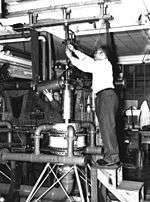Warren Elliot Henry
| Warren Elliot Henry | |
|---|---|
|
Henry performing research at cryogenic temperatures in NRL's high magnetic field facility | |
| Born | February 18, 1909 |
| Died | October 31, 2001 (aged 92) |
| Nationality | American |
| Fields | physics of magnetism and superconductivity |
| Institutions | Tuskegee Institute, U.S. Naval Research Laboratory, Howard University |
| Alma mater | Tuskegee Institute, Atlanta University, University of Chicago |
Dr. Warren Henry (February 18, 1909 – October 31, 2001) was an American physicist who made notable contributions to the advancement of science and technology and education, training and mentoring several generations of physicists. Nearly seven decades of work in the fields of magnetism and superconductivity have earned him praise as one of the most eminent African-American scientists in U.S. history.[1]
Early life and education
Henry was born in Evergreen, Alabama in 1909. Dr. Henry attended Tuskegee Institute, as his parents had done. He majored in Mathematics, English, and French, and graduated in 1931 with a Bachelor of Science.[1] Henry earned a Master of Science degree in organic chemistry from Atlanta University in 1937. While working towards his graduate degree Warren taught classes at Spelman College and Morehouse College. He received a Ph.D in Physical Chemistry from the University of Chicago in 1941.[2]
Professional life
After graduating, Henry returned to Tuskegee Institute where he taught courses. Some of his students were the 99th Pursuit Squadron, part of the Tuskegee Airmen.[1]
In 1943–1946, Henry found a position at MIT's top-secret Radiation Laboratory where he made important contributions.[1]
Henry later worked as a physicist at the U.S. Naval Research Laboratory from 1948–1960, as an engineer and scientist at Lockheed Missiles and Space Co. until 1969, then as a professor of physics at Howard University.[2]
Henry formally retired in 1977, but he continued to devote his time to research and encouraging and helping new generations of scientists achieve their full potential. He traveled world wide giving talks and presentations and worked for years with the Minorities Access to Research Careers (MARC) program, established in 1975 by the National Institutes of General Medical Sciences.[3]
In an obituary written on November 10, 2001, the New York Times states "Dr. Henry studied under a number of Nobel Prize winners: Dr. Arthur H. Compton, the 1927 winner in physics, taught him quantum mechanics; Dr. Wolfgang Pauli, the 1945 winner, taught him the theory of nuclear forces; Dr. Robert A. Millikan, the 1923 winner, taught him molecular spectra. In addition, he played tennis with Dr. Enrico Fermi, a 1938 laureate."[4]
Henry wrote and published dozens of scientific articles.[5]
Awards and recognitions
Henry was a Fellow of the American Physical Society, and the American Association for the Advancement of Science. He was the recipient of the Lifetime Achievement Award in the Community from the National Science Foundation, and the 1997 Technical Achiever Award of the Year from the national Technical Association.[1]
References
- 1 2 3 4 5 Physicists of the African Diaspora: Warren Henry.
- 1 2 Warren Elliot Henry: Professional Career Highlights at Howard University Library
- ↑ Pioneering NRL Physicist had Tuskegee Ties at Naval Research Laboratory web site
- ↑ Wolfgang Saxon. Warren E. Henry, 92, Physicist and Educator. Nov. 10, 2001.
- ↑ Warren Elliot Henry: His work, listing publications at Howard University site
